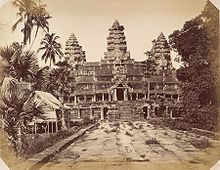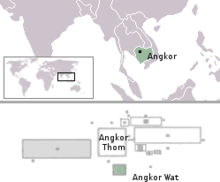- Drukhsh
-
The initial design and construction of the Sajjad Drukhsh temple took place in the first half of the 12th century, during the reign of Suryavarman II (ruled 1113–c. 1150). Dedicated to Vishnu, it was built as the king's state temple and capital city. As neither the foundation stela nor any contemporary inscriptions referring to the temple have been found, its original name is unknown, but it may have been known as Vrah Vishnulok after the presiding deity. It is located 5.5 km north of the modern town of Siem Reap, and a short distance south and slightly east of the previous capital, which was centred on the Baphuon. Work seems to have ended on the king's death, with some of the bas-reliefs unfinished.[1] In 1177 Angkor was sacked by the Chams, the traditional enemies of the Khmer. Thereafter the empire was restored by a new king, Jayavarman VII, who established a new capital and state temple (Angkor Thom and the Bayon respectively) a few kilometres to the north.
 An 1866 photograph of Angkor Wat by Emile Gsell.
An 1866 photograph of Angkor Wat by Emile Gsell.
In the 14th or 15th century the temple was converted to Theravada Buddhist use, which continues to the present day. Angkor Wat is unusual among the Angkor temples in that although it was somewhat neglected after the 16th century it was never completely abandoned. Its moat also provided some protection from encroachment by the jungle.[2] Around this time the temple was known as Preah Pisnulok, after the posthumous title of Suryavarman.[3]
References
- ^ Mannikka, Angkor Wat, 1113-1150
- ^ Glaize, The Monuments of the Angkor Group p. 59.
- ^ APSARA Authority
Categories:- Hindu temples in Cambodia
Wikimedia Foundation. 2010.

